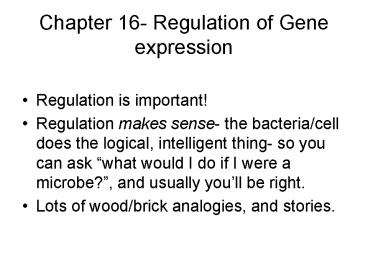Chapter 16 Regulation of Gene expression - PowerPoint PPT Presentation
1 / 24
Title:
Chapter 16 Regulation of Gene expression
Description:
Regulation makes sense- the bacteria/cell does the logical, intelligent thing ... The enzyme that produces cAMP (adenyl cyclase), is inhibited by allosteric ... – PowerPoint PPT presentation
Number of Views:63
Avg rating:3.0/5.0
Title: Chapter 16 Regulation of Gene expression
1
Chapter 16- Regulation of Gene expression
- Regulation is important!
- Regulation makes sense- the bacteria/cell does
the logical, intelligent thing- so you can ask
what would I do if I were a microbe?, and
usually youll be right. - Lots of wood/brick analogies, and stories.
2
Some terms
- Inducible- the environmental effect (specific
molecule) turns it on - Constitutive- always on
- repressible- the environmental effect (specific
molecule) turns it off. - negative control- regulator turns it off.
- positive control regulator turns it on.
3
Selected Bacterial Operons
- OPERON coordinately regulated genes, usually on
the same mRNA in bacteria. - By turning genes on and off in response to the
environment, the cell works more efficiently,
only making gene products needed at that time. - Lac operon catabolism of lactose. 2 enzymes
needed - lac permease brings lactose in
- ß-galactosidase splits into glucose and
galactose. - Fuel.
4
(No Transcript)
5
Control system fig 16-1-7 This is the situation
when no glucose is present, and lactose induces
the operon. Please study these figures!!!!
6
Repressor acts negatively to inhibit
transcription. www.prenhall.com/klug
7
Proof isolation and behavior of constitutive
mutants, such as Oc and lacI-, and
dominance/recessive behavior as merodiploids.
Table 16.1 Also biochemistry- isolation of
repressor protein, binding characteristics to
operator, etc.
8
However, good repressor will work, so an I-/I
merodiploid will be regulated.
9
A good operator will NOT work to restore
regulation!!
10
A superrepressor (Is) will bind, shutting off
transcription, no matter what- it will be
dominant over an I
11
CAP protein and positive regulation
- When glucose is in abundance, the lac operon is
not turned on, even when lactose is present!
Makes sense! - Regulation involved CAP, cAMP, and RNA polymerase
- CAP catabolite activator protein stimulates
transcription when cAMP levels are high.
12
- cAMP Fig. 16-8 Formed when glucose levels are
low. The enzyme that produces cAMP (adenyl
cyclase), is inhibited by allosteric interaction
with glucose. Thus as glucose levels fall, the
enzyme is more active, cAMP levels rise. - CAP cAMP bind to promoter, turns weak promoter
into STRONG promoter!
13
CAP is kind of like a transcription factor-
acting, stimulating transcription
CAP regulates probably 50 genes- NO sugar or
other carbon source would be used, as long as
glucose is there!
14
(No Transcript)
15
Tryptophan biosynthesis
- Trp amino acid ( bricks) building block.
- trp operon genes for making tryptophan.
- trp is on when tryptophan levels are low off
when levels are high.
16
(No Transcript)
17
MORE allosteric interaction!
18
Gene regulation in eukaryotes
- I. Some considerations (Fig. 16-12)
- a. lots more DNA chromatin has histones, which
have to be considered. Chromatin can be
available for transcription (decondensed) or
unavailable (condensed), which makes a BIG
difference! - b. transcription in the nucleus, translation in
the cytoplasm - c. processing caps, tails, splicing.
- d. long half-life of mRNA in our cells! in
bacteria, its about 3 min ours is 20 min or
longer. - e. cell differentiation not only environment,
but cell type influences gene expression. (i.e.,
no hairy livers!)
19
(No Transcript)
20
(No Transcript)
21
(No Transcript)
22
(No Transcript)
23
(No Transcript)
24
(No Transcript)































